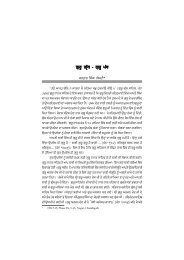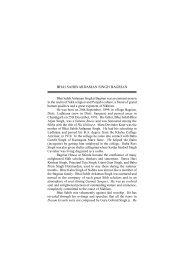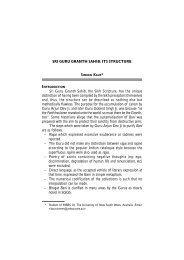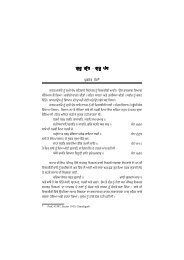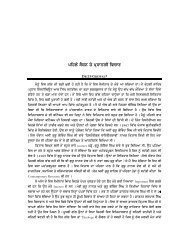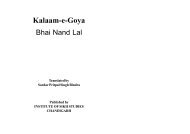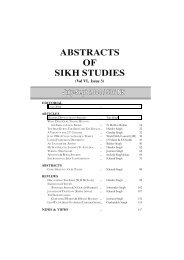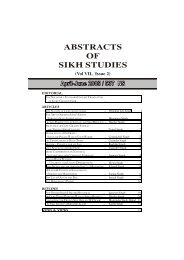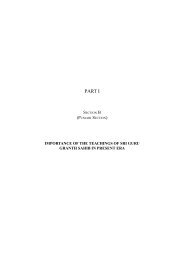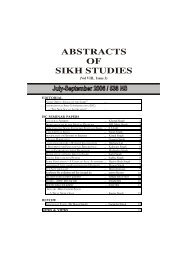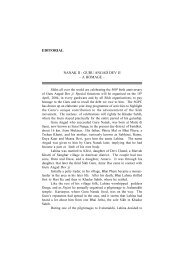You also want an ePaper? Increase the reach of your titles
YUMPU automatically turns print PDFs into web optimized ePapers that Google loves.
68ABSTRACTS OF SIKH STUDIES : JAN-MARCH <strong>2006</strong> / 537-38 NSdistance, but once he was dead, they made their move, as thecontemporary Muslim poet <strong>of</strong> the day Shah Muhammed writes, “<strong>Jan</strong>gHind Punjab da hon laggah..dovehn patshahi faujaan bharian ne” (on oneside was the Khalsa Army <strong>of</strong> Punjab and on the opposite side was theBritish Allied Army <strong>of</strong> the Conquered Indians). After two <strong>of</strong> thebloodiest wars, known as the Anglo-<strong>Sikh</strong> wars, the British eventuallywon and annexed the Punjab. From then on the <strong>Sikh</strong>s became a majorforce in the British Allied army as the British gradually consolidatedtheir hold over India, and during the failed and ineffective IndianMutiny <strong>of</strong> 1857, it was the <strong>Sikh</strong>s that helped save the British, andafter Indian Independence, the <strong>Sikh</strong> community, half <strong>of</strong> which had t<strong>of</strong>lee Muslim Pakistan after partition, became economically andpolitically the most significant and successful minority community inIndia. The <strong>Sikh</strong>s are unique as a religious movement. Founded in thedeepest spirituality and mysticism, they are a radically egalitarian grouprooted deeply in their sense <strong>of</strong> community, called “brotherhood”(Khalsa ), and history.The Khalsa is unified by one aspect: all <strong>Sikh</strong>s are disciples <strong>of</strong> thefounding Gurus <strong>of</strong> the religion – the word, “<strong>Sikh</strong>,” means disciple.They are also, however, a highly militant religion and society; thecommunity has to be protected with the highest martial vigilance andability. Since the seventeenth century, <strong>Sikh</strong> fighters have been fearedthroughout India for their ability and sheer courage. The British, whoemployed them in their army in the nineteenth century, referred tothem as the greatest <strong>of</strong> the “martial races.”It’s an odd mixture, Miri and Piri, something unique to <strong>Sikh</strong>ism.On the one hand, <strong>Sikh</strong>ism is one <strong>of</strong> the most deeply spiritual andpr<strong>of</strong>oundly mystical religions <strong>of</strong> the world, advocating a social harmonyand egalitarianism unrivalled by any other major religion, with thepossible exception <strong>of</strong> Buddhism. On the other hand, the <strong>Sikh</strong>community is a militant, warrior community, willing to fight, sacrifice,at any cost to protect or further the interest <strong>of</strong> their community.The core teaching <strong>of</strong> <strong>Sikh</strong>ism is one truth: that God is one Godand is behind and present in all <strong>of</strong> creation, particularly in each humansoul. God can be directly connected to by an individual by examininghis or her soul; this examination is carried out by meditating on thename <strong>of</strong> God. There is no need <strong>of</strong> any intermediary functionary, such



